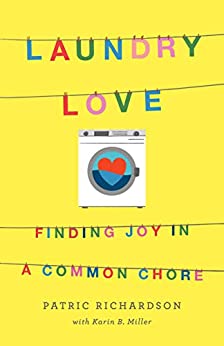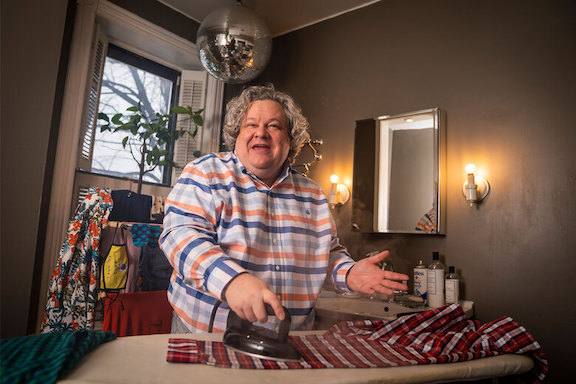My grandmother used to say “Nobody likes to do laundry, but everybody likes clean clothes.” I remember helping her wash and hang laundry when I stayed with them. These are just two reasons I loved Patric Richardson’s book Laundry Love (written with Karin B. Miller).

The book first hit my radar from a March Wall Street Journal article. It covered Richardson’s work, laundry camps, and upcoming book and tv series. Like any good gumshoe (there’s a way to clean that!) I hit the internet to see what it was all about. There I found several delightful interviews filled with unbelievable (and unbelievably simple) tips for better laundry.
I was originally on the fence about getting the physical copy because I was certain most of the stuff was already online. When I checked out the e-sample online and knew I was going to have to get it as soon as he started his cast of characters with his beloved Granny Dude.
If cleanliness is really next to godliness then Patric is certainly fitting the title of “The Laundry Evangelist.” My dry clean only stage came a lot later in life than his, nice clothes were always part of my childhood. My dad’s parents were chronic clothes gifters. That was really all he and my aunt every got for Christmas or birthdays. The home movies I have of my early birthdays look pretty much the same.
Jekyll and Hyde
The clothes always came with a warning though. These are for school and/or Sunday school, they were strictly not play clothes. In this sense I had a very Jekyll and Hyde closet. School and church clothes lived on one side and work and play clothes lived on the other. My dad worked at Goodyear and everything we had was washed on heavy duty settings and dried on a clothesline until we eventually got a dryer.
But, back to the book. This book is as delightful as it is useful. It is a mix of memoir and how to with some amazing recipes included for good measure. A lot of the how to’s are mentioned in many of the online videos. The book goes into more depth and the memoiresque arrangement provides some interesting context. Learning why we do things they way we do was as interesting as learning the better way to do it.
It was particularly fun to read now as my son, who is almost three, has been helping with laundry since he was old enough to walk. I have videos of him pulling himself across the dryer door grabbing something from the back of the dryer and throwing it into the basket. The kid is also a whiz with the stand mixer in the kitchen. It’s pretty handy that after making brownies or cookies to be able to show him how we can keep all of our stuff clean.
Experimenting
The first thing I tried from his advice was swapping wool dryer balls and an aluminum foil ball for dryer sheets. The second was switching to soap flakes. I wish I had started doing this when I first started doing my own laundry when I was in Jr. High. My clothes have never felt better and drying time has been cut by at least 30%. Our King-sized duvet now dries in about an hour instead of 1.5. I don’t have to stop it halfway to reshuffle it back into the dryer with the damp side out.
Even if you aren’t wearing dry clean only all the time (I probably bring the average up, see #50suitsin50days , #suittothrill , and #habiliments? over on my instagram), or don’t find yourself in serious stain predicaments there is still a lot you can glean from this book. If nothing else there is the sheer joy of the story.
Gift this book to every graduating senior heading off on their own. If you know a few, I’d even suggest making it part of a small gift basket. The book, some soap flakes, sodium percarbonate (oxy clean without the branding and added fragrances), and a few little spray bottles with the go-to agents. He even tells you how you can make ye olde theatre trick of vodka freshening work in places where you can’t (or shouldn’t) have consumable liquor.
Domestic Science
As a Historian of Science reading about all the processes and the chemical explanations makes me want to put this book up with all the recent titles that advocate for cooking as a science and develop a whole class around domestic sciences. You know the ones that people don’t consider “sciencey” mostly because it was everyday women’s work.
As an exhibits coordinator I am more than a little envious of his experience with the Mona Williams Bismark wardrobe at UK. There are also now several exhibits percolating in my head about the evolution of laundry.
I also felt greatly vindicated by his note that we wash our clothes too much. I still hang my button shirts to dry and only wash them if they are dirty. Sometimes that is only a couple times a year. I have shirts that are well over 10 years old and they generally only come out of rotation (or go to the “work” side of the closet” because of natural decay. Usually this is fraying where the collar or the cuffs rub my neck and wrists.
We lived probably 20 miles from the nearest dry cleaner and most of the people in my family didn’t wear much dry clean only. Some dresses and a suit or two. Instead of doing what Granny Dude did and learn to take care of them everyone just yelled at you to be careful doing anything in your good clothes. Best not to even breathe too dirtily either. I think this is fairly common in rural areas and part of the aversion to dressier clothes. The other part is off the rack wear and lack of tailoring but that is another post for another day.
Common Laundry
The book also reminded me of things I hadn’t thought about in a very long time. Seeing relatives use old ringer washing machines and having a rub board when we went to the lake. Seeing my mother taking in jeans while on crutches with a sprained ankle when I was too young to help. I don’t think I will ever forget seeing her with jeans draped around her shoulders like a graduation stole hobbling back into the house.
There was also the time I was going to do my grandmother (the washer kicking one) a favor. I would update her clothesline with new, more taunt line. She was 5-foot-nothing. By the time I got the lines good and tight so they wouldn’t bend so low that sheets touched the grass, they were too tall for her to reach. We had to go out and trial and error it back down to the right height. If the grass wasn’t mown sheets still touched the grass.
The Sheep Got Wet
I will leave you with the link to the first video interview I watched after reading about this book. It’s also a great argument for listening to Patric read the book as an audiobook. You’ll still want the hard copy to reference back to for the cleaning instructions and the recipes. The biggest complaint I’ve seen was that the book wasn’t indexed. I think these people wanted a technical manual for stains. This book is so much more than that, and all the more better for it.
There are two lines in this video that I find myself constantly thinking about, repeating (in my head or even out loud), and laughing (in my head and more often out loud) at almost daily. One is “the sheep got wet.” The other (and possibly my favorite) is, “look, the geese lived with the sheep.”

